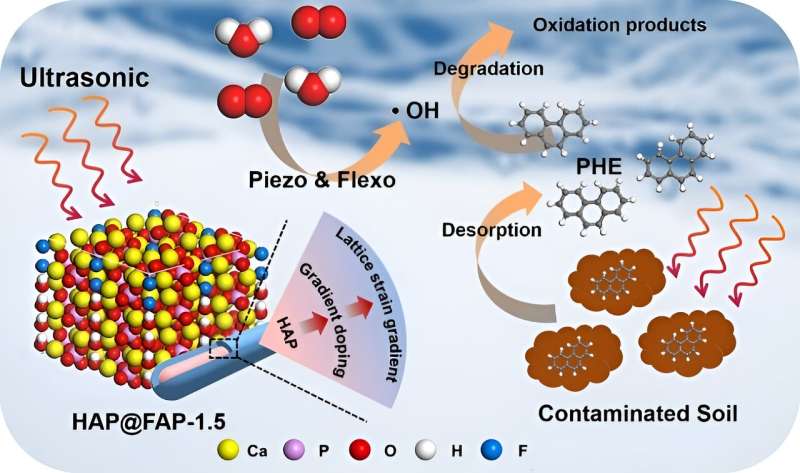This article has been reviewed according to Science X's editorial process and policies. Editors have highlighted the following attributes while ensuring the content's credibility:
fact-checked
proofread
Novel mineral piezocatalysts offer innovative approaches for soil remediation

Polycyclic aromatic hydrocarbons (PAHs) removal in the soil environment is of great significance for repairing the long-term damaged ecosystem. However, the poor mass transfer process and low catalytic activity in most conventional methods lead to limited removal efficiency.
A team of scientists has constructed a gradient F-doping hydroxyapatite core-shell structure (HAP@FAP) with the coupling effect of flexoelectricity and piezoelectricity for degradation of PAHs in soil that provide innovative approaches for soil remediation. Their work was published in the journal Industrial Chemistry & Materials.
The poor mass transfer process in conventional soil remediation methods remains a significant factor that hampers their further application. Recently, piezocatalysis has been developed as a new energy conversion technology. The mechanical vibration (ultrasound or stirring, etc.) can induce lattice distortion of piezocatalysts and accelerate mass transfer in the soil system, leading to enhanced piezocatalytic degradation of PAHs in soil, which shows great potential in soil remediation.
Hydroxyapatite (Ca10(PO4)6(OH)2, HAP), as natural mineral piezocatalysts, exhibit unique advantages of environmental friendliness in the field of piezocatalytic soil remediation. However, the biggest challenge is the weak piezoelectric coefficient (1–16 pm V-1) of HAP, leading to low catalytic activity.
"How to construct HAP-based mineral piezocatalysts with high piezocatalytic activity for soil remediation is the direction of our team's efforts," explains Jianmei Lu, a professor at the Soochow University.
The researchers successfully fabricated a gradient F-doping HAP@FAP core-shell structure via a simple ion exchange method, which induced the coupling effect of piezoelectricity and flexoelectricity by built-in strain gradient for enhanced piezocatalytic activity.
The oxidative degradation of phenanthrene (PHE) in soil (200 mg kg-1) was carried out to evaluate the piezocatalytic activities of catalysts. HAP@FAP exhibited the optimized piezocatalytic activity that 79% PHE can be degraded under ultrasonic vibration for 120 min. This is significantly superior to pristine HAP and F-HAP with a solid solutions structure. In addition, the effects of catalyst dosage, water-to-soil ratio, and ultrasonic power on degradation performance were investigated.
The research team also proposed the possible mechanism of PHE degradation caused by piezoelectric polarization. The lattice strain gradient generated in the gradient F-doping core-shell direction induced flexoelectricity enhanced piezocatalytic activity.
Under continuous ultrasonic vibration, the polarized electric field in HAP@FAP drove charge carriers to the surface, generating reactive oxygen species for oxidative degradation of PHE ultimately into CO2 and H2O, achieving the goal of harmless treatment of soil pollutants.
Looking ahead, the research team hopes that their work might provide insights for the modification of piezoelectric catalysts for the remediation of organics-contaminated soils from industrial land. "We next plan to scale up to achieve the ultimate goal of industrial application. Our developed catalyst may be potentially applied in various persistent organic pollutants contaminated industrial land, such as polychlorinated biphenyls and naphthalene," said Lu.
More information: Jun Han et al, Flexoelectricity in hydroxyapatite for the enhanced piezocatalytic degradation of phenanthrene in soil, Industrial Chemistry & Materials (2023). DOI: 10.1039/D3IM00093A
Provided by Industrial Chemistry & Materials





















